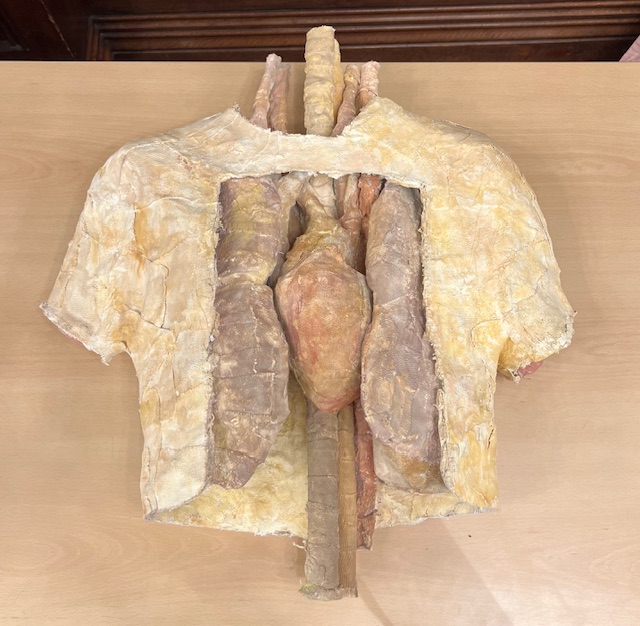We aimed to create a model to illustrate the invaluable contribution of body donations to medical science and our understanding of anatomy. While the bodies provided lack personal identities, we handle them with the upmost care and gratitude, recognising their crucial role in teaching aspiring medical professionals. The anatomy lab serves as a vital learning space, allowing us to closely examine different body systems and comprehend concepts that go beyond textbook memorisation.
To construct our model, we took a mould of a fellow medical student’s torso using papier-mâché and reinforced it with plaster of Paris to simulate the real size and weight of the human body; we wanted our sculpture to feel like the specimens in the dissection room – recognisable as a human body but different to any living bodies we had seen prior to medical school. We initially decided not to colour the model with the aim of emphasising the contrast between living bodies and the preserved specimens used for education. However, we later made the decision to incorporate the true colours from our anatomy sessions to highlight the educational purpose of these practices. Direct tactual explorations during the anatomy sessions informed the evolving aesthetic representation throughout.
Our creative process revealed the inadequacy of textbooks in accurately reproducing lifelike human anatomy, emphasising the irreplaceable role of hands-on experiences in medical education. Whilst we acknowledge that a creative piece cannot fully capture the value of body donation to medical science, as fascinated medical students, replicating what we’ve learned allowed us to conceptualise and appreciate the anatomical knowledge gained through the extreme generosity of donors.
We worked closely together to make ongoing adjustments and ensured everyone felt that their opinions were heard. The process of creating a model that resembled a realistic cadaveric specimen was challenging and time-consuming, much like our experience learning the detailed anatomy of the human body in the dissection room. Creating our sculpture was not only valuable in that it developed our ability to work methodically and as a team but it also served as opportunity to strengthen our anatomical knowledge through reflections in our practical sessions and the hands-on experience of replicating what we saw.
Flora Macinnes, Avneet Sohal and Aimee Leighton
Effective Consulting Year 1
This was the First-Prizewinning Creative Piece voted by student peers at the Foundations of Medicine Conference 2023

0 Comments